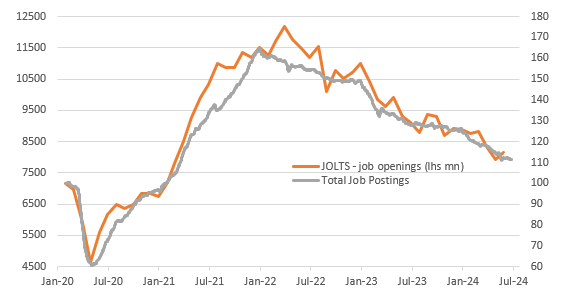


David Gyung
Job openings rose to 8140k in May from a downwardly revised 7919k in April. This is above the 7946k that was expected. We use the Indeed job website’s total job postings numbers as a guide when we put our forecast for job openings together and as the chart below shows, the series tends to fluctuate around where Indeed’s numbers are. The trend remains one of shrinking vacancy numbers with the US economy tending towards pre-pandemic levels and likely hitting that point before the end of this year.
Job openings versus Indeed job postings
Source: Macrobond, ING
The quits rate was the big warning signal of an impending spike in labour costs that ensured inflation took off in 2021 and remained elevated ever since. As firms looked to rehire as the economy re-opened, firms were having to pay up to attract staff and this incentivized workers to move to new employers. In turn, as companies experienced higher staff turnover we saw bosses being more prepared to raise pay to retain staff. However, the swing sharply lower in the quits rate suggests that the jobs market is cooling with firms less willing to pay up to recruit staff or workers themselves becoming more reluctant to move. This is already prompting a slowdown in employment costs that we think will intensify through the second half of the year, as suggested in the chart below, and help to slow inflation pressures in the economy more broadly.
Source: Macrobond, ING
This all follows on from some tentatively dovish comments from Fed Chair Jerome Powell, who has been speaking at the ECB’s Forum on Central Banking in Sintra, Portugal. He acknowledged that the economy and jobs market has been strong, but that inflation is showing “signs of resuming its disinflationary trend” together with a “rebalancing in the labour market”. He refused to be drawn on the timing of any potential rate cut, but markets are now pricing around a 75% chance of a cut at the September FOMC meeting and we agree.
If we get another couple of 0.2% month-on-month or below core inflation prints, unemployment breaking above 4% and more evidence of cooling consumer spending growth, we believe the Fed will start to move monetary policy from restrictive territory to “slightly less” restrictive territory in 25bp increments down to around 4% by mid-2025.
Editor’s Note: The summary bullets for this article were chosen by Seeking Alpha editors.